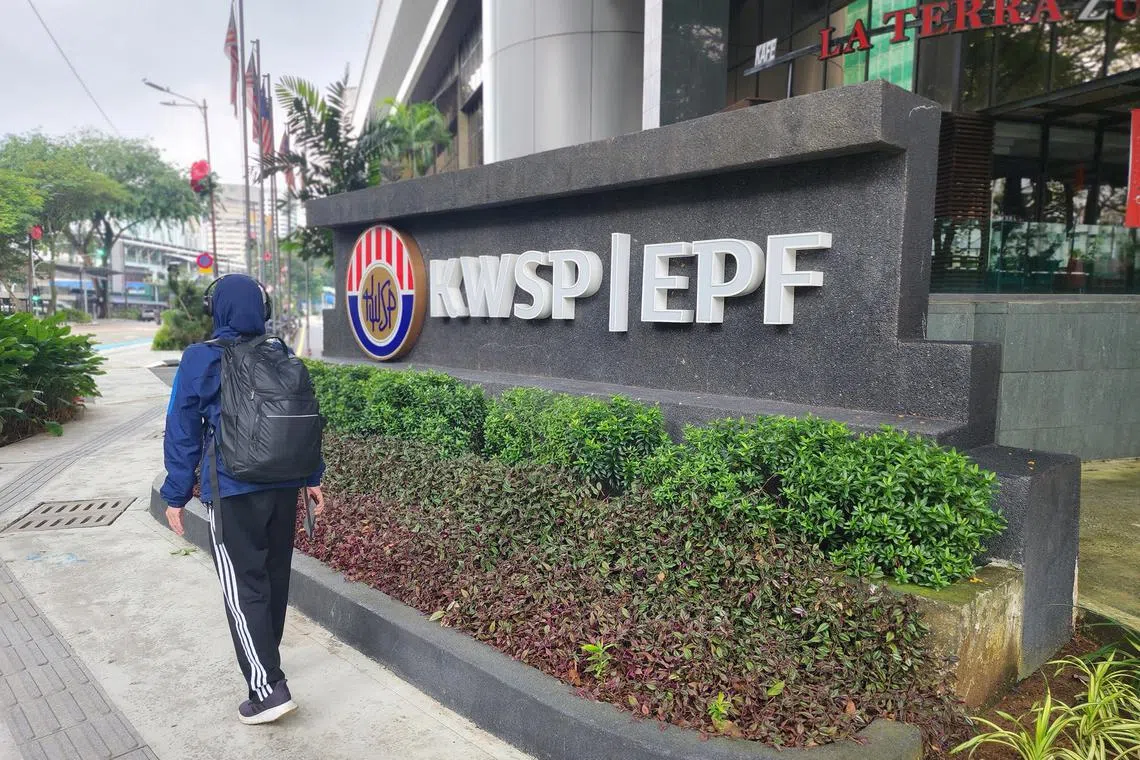Bleak retirement looms for many Malaysians with insufficient pension fund savings
Sign up now: Get ST's newsletters delivered to your inbox

The Employees Provident Fund manages the compulsory savings plan and retirement planning for workers in the country.
ST PHOTO: HAZLIN HASSAN
Follow topic:
KUALA LUMPUR - Freelance writer Nadrah Hizwan is 29, but already thinking about her retirement funds.
She paused regular contributions to the Employees Provident Fund (EPF) after going freelance two years ago to take care of her young son, but tries to make contributions every few months or so.
“I am not too stressed yet because retirement still feels far off,” the former academic editor told The Straits Times. She hopes to be able to return to full-time work soon to boost her retirement savings.
To date, she has around RM38,000 (S$11,600) accumulated in her EPF account, as well as additional funds in a government-backed unit trust and a pilgrimage fund.
However, Ms Nadrah is among the minority when it comes to planning ahead. A recent report by the Khazanah Research Institute (KRI) reveals a worrying trend of many EPF members being poorly prepared for retirement.
The Malaysian retirement fund, which is similar to Singapore’s Central Provident Fund, manages the compulsory savings plan and retirement planning for workers in the country.
More than 90 per cent of these EPF members, aged 30 and below, will not have enough basic savings of at least RM240,000 needed to retire comfortably
Individuals need at least RM35,000 saved by the age of 30 to meet this retirement goal. But most people under 30 have not met this benchmark, states the report titled The State Of Households 2024: Households And The Pandemic 2019-2022.
KRI also noted that individuals aged between 30 and 54 are similarly unprepared, largely due to EPF withdrawals made for education purposes or home purchases.
This was worsened by the Covid-19 pandemic, with the governments of then prime ministers Muhyiddin Yassin and Ismail Sabri Yaakob allowing partial withdrawals of retirement funds to alleviate economic hardship.
With a total of RM145 billion withdrawn from EPF accounts during the pandemic – representing some 15 per cent of total assets under EPF of RM1 trillion – many are left with depleted savings.
Just 10 per cent of contributors aged 30 to 54
The report said that targeted government interventions, such as raising minimum wages and better wage-setting mechanisms, would help to combat wage stagnation and ensure financial stability for lower-income households.
Low starting salaries mean that many are unable to contribute adequately to their EPF, leading to compounded challenges over time.
EPF contributions are a must for workers who earn at least RM10 a month. Malaysian workers pay 11 per cent of their monthly salaries to the pension fund, while employers contribute 12 per cent to 13 per cent.
The current minimum wage in Malaysia is RM1,500 a month, last revised in 2022, noted Dr Nur Syazwani Mazlan, a senior lecturer in econometrics and business statistics at Monash University Malaysia.
She suggests a minimum 20 per cent increase to better match living wages with the rising cost of living, particularly in urban areas. “Strengthening mandatory savings programmes and ensuring consistent contributions are crucial,” she said.
The EPF has a total membership of around 16 million.
About 6.1 million members (or 38 per cent) have less than RM10,000 in their accounts, with 3.6 million members having less than RM1,000, said Dr Nur Syazwani. She said that weak finances could compel many to rely on family support or to continue working beyond the retirement age.
Malaysia’s mandatory retirement age for civil servants starts at 55, with an option to retire as late as 60, while the retirement age in the private sector is set at 60, but there is more flexibility in that regard.
Communications consultant Anita Pandian, 48, worries about not having enough saved to retire comfortably.
“I am worried that I may not have enough savings to sustain me until 60 or 70,” said Ms Pandian, who has a college-age daughter, adding that she plans to work for as long as possible.
The KRI report also indicated that the RM240,000 target may be insufficient for retirement needs as life expectancy rises – individuals would likely need more than just RM1,000 per month for the next 20 years upon retiring.
There are also cost-of-living and ageing-related issues to factor in, economists say.
The EPF paid out between 5.2 per cent and 6.1 per cent in annual dividends between 2019 and 2023. Malaysia’s inflation rate was at 2.49 per cent in 2023.
Challenges will arise as Malaysians live longer, warned Dr Shankaran Nambiar, an economist at a local non-profit organisation. The average Malaysian life expectancy is around 75 years.
“The government will have to think of social security schemes that address this problem at the policy level,” he said, calling for a robust healthcare financing system to support retirees.
AmBank chief economist Firdaos Rosli said that solutions should involve higher wage growth, increased EPF contributions or extending the retirement age, or all of the above.
The pressing need for action is evident, said Dr Nur Syazwani, as nearly 73 per cent of EPF members are in “a serious state of having inadequate funds to retire above the poverty line”.
“Addressing this issue is crucial to ensure a secure and dignified retirement for all, requiring a combined effort from both the government and individuals,” she added.


